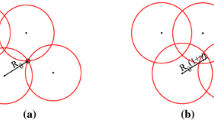Abstract
The solution of operator equations with radial basis functions by collocation in scattered points leads to large linear systems which often are nonsparse and ill-conditioned. But one can try to use only a subset of the data for the actual collocation, leaving the rest of the data points for error checking. This amounts to finding “sparse” approximate solutions of general linear systems arising from collocation. This contribution proposes an adaptive greedy method with proven (but slow) linear convergence to the full solution of the collocation equations. The collocation matrix need not be stored, and the progress of the method can be controlled by a variety of parameters. Some numerical examples are given.
Similar content being viewed by others
References
R.A. DeVore and V.N. Temlyakov, Some remarks on greedy algorithms, Adv. Comput.Math. 5 (1996) 173–187.
G. Fasshauer, Solving partial differential equations by collocation with radial basis functions, in: Surface Fitting and Multiresolution Methods, eds. A. LeMéhauté, C. Rabut and L.L. Schumaker (Vanderbilt Univ. Press, Nashville, 1997) pp. 131–138.
A. Faul and M.J.D. Powell, Proof of convergence of an iterative technique for thin-plate spline interpolation in two dimensions, Preprint DAMTP 1998/NA08.
C. Franke and R. Schaback, Convergence order estimates of meshless collocation methods using radial basis functions, Adv. Comput. Math. 8 (1998) 381–399.
C. Franke and R. Schaback, Solving partial differential equations by collocation using radial basis functions, Appl. Math. Comput. 93 (1998) 73–82.
Y.C. Hon, Multiquadric collocation method with adaptive technique for problems with boundary layer, Internat. J. Appl. Sci. Comput. 6 (1999) 173–184.
Y.C. Hon, K.F. Cheung, X.Z. Mao and E.J. Kansa, A multiquadric solution for the shallow water equations, ASCE J. Hydraulic Engrg. 125 (1999) 524–533.
Y.C. Hon and X.Z. Mao, An efficient numerical scheme for Burgers' equations, Appl. Math. Comput. 95 (1998) 37–50.
Y.C. Hon and Z. Wu, A quasi-interpolation method for solving stiff ordinary differential equations, Internat. J. Numer. Methods Engrg. 48 (2000) 1187–1197.
E.J. Kansa, Multiquadrics-a scattered data approximation scheme with applications to computational fluid dynamics-II. Solutions to hyperbolic, parabolic, and elliptic partial differential equations, Comput. Math. Appl. 19 (1990) 147–161.
M.F. Milroy, G.W. Vichers and C. Bradley, An adaptive radial basis function approach to modeling scattered data, J. Appl. Sci. Comput. 1 (1994) 319–349.
R. Schaback, Native spaces of radial basis functions I, in: International Series of Numerical Mathematics, Vol. 132 (Birkhäuser, Basel, 1999) pp. 255–282.
R. Schaback and H. Wendland, Adaptive greedy techniques for approximate solution of large RBF systems, Numer. Algorithms 24 (2000) 239–254.
V.N. Temlyakov, The best m-term approximation and greedy algorithms, Adv. Comput. Math. 8 (1998) 249–265.
Author information
Authors and Affiliations
Rights and permissions
About this article
Cite this article
Hon, Y., Schaback, R. & Zhou, X. An Adaptive Greedy Algorithm for Solving Large RBF Collocation Problems. Numerical Algorithms 32, 13–25 (2003). https://doi.org/10.1023/A:1022253303343
Issue Date:
DOI: https://doi.org/10.1023/A:1022253303343




